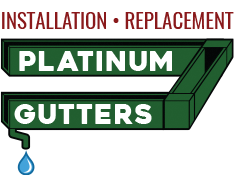Frequently Asked Questions
Most of the home owners we work with at Platinum Gutters would rather not spend their time doing hours of research into gutter installatio, and replacement. However, when you have gutters that are rusted, bent, leaking, or no gutters at all, it’s time to do a little research. Our knowledgeable team is available to help anytime. Simply call our team with any questions. We’ve also compiled the following answers to some of the questions we answer most often, to get you started.
What should I know before installing a new gutter system?
Start with the basics. You need a properly installed system that will lead water away from your roof and the sides of your home, and you should make sure there is a warranty in case of any unforeseen failing within the first few years following installation. In the world of gutter installation, there are three things you should know. First, supports should be two feet apart. Second, the back of the gutter needs to start behind the roof flashing so water does not leak between the gutter and the fascia board that runs along the lower edge of the roof into the home. Third, choose an oversized downspout to ensure easy removal of debris and other non-water items. Unfortunately, many companies do not follow the first two standards rigorously, but the Platinum Gutters team always do.
What feature upgrades do you recommend to improve a current gutter system?
Whether you’re installing a brand new system or want to improve the efficacy of your current gutters, the best option is to install larger downspouts. These allow for easier and faster draining and clog much less frequently. Even if your gutters are completely clear of debris, water itself is very heavy. One gallon of water can weigh nearly ten pounds, so during rain storms, your gutters need to accommodate heavy weight and fast moving water. The old standard downspouts were two by three inches. We recommend doubling the square inches by choosing an oversized downspout of three by four inches. It will not look dramatically different, but your gutter system will drain water and other debris significantly better.
Cleaning the gutters isn’t a fun job for any homeowner, so how often do I really HAVE to do it?
Unfortunately, there is no single answer to this question. To start with, we recommend you consider having your gutters cleaned annually by a professional. In addition to doing a very thorough job removing debris and other buildup in the gutters, they can check for leaks, looseness, or other concerns. When it comes to regular maintenance cleaning, the time of year impacts how often the gutters should be cleared. Most people need to clean their gutters most often in the fall when leaves are falling. A good rule of thumb is, if you have to remove leaves from your porch or patio, you likely need to clean your gutters. The same goes for pollen buildup, nut-producing trees, insect infestations, and other instances where there is a greater chance of buildup in the gutters.
What are the easiest gutters to maintain, clean, and keep working effectively?
When it comes to easy, maintenance free gutters, it’s no secret that leaves and other debris are your chief concern. You can purchase screens or solid-top leaf guards to prevent buildup, clogging, and reduce the frequency of cleanings even when leaves are being lost regularly during the fall season. One of the most innovative leave protection technologies for gutters is the solid-top curved bullnose leaf protector. This unique design allows water to enter easily by wrapping around the nose, but other debris is unable to penetrate the smaller opening and is deflected off of the gutter to the ground.
What gutter materials are the best and longest lasting?
Steel is known to be the strongest metal and many of our customers think this is their best option. However, steel rusts no matter how much time and money you invest in protectants, so other less durable metals may actually be a better option. Copper and aluminum are both durable, quality metals that don’t rust, so when installed and maintained properly, aluminum and copper gutter systems can last for decades. Contrary to popular belief, aluminum gutters are not like a coke can. They come in a variety of gauges, thickness of metal, but typically between .027 and .032 gauge aluminum is adequate even for climates that receive heavy snow fall.
Are seamless or sectional gutters better?
It is highly unlikely that any home-improvement company would recommend a sectional gutter to any home owner. Seamless gutters significantly limit the chances for leaks and other maintenance concerns associated with sectional guttering. With seamless gutters, you will only have leak potential at the corners. Additionally, though the face value of sectional gutters may appear to be less than seamless gutters, they actually take significantly longer to install, which will increase the labor costs making sectional and seamless guttering comparably priced.
What shape should the gutter be?
We recommend the K-style gutters most often. They have a larger capacity than the comparable half-round gutters to prevent clogs and improve drainage. However, half-round gutters are actually very popular in the DFW Metroplex, and we install these regularly with no complaints from our customers, so we’ll be happy to discuss either option with you.
What color are gutters, and can I get them to match the color of my home?
Gutter systems do come pre-painted in a variety of colors that can easily be chosen to match any exterior house color. Additionally, gutters can be repainted if you change the color of your home down the line. Our sister company, Platinum Painting would be happy to work with you on this project.
Do I need to decide where to place the downspouts?
In most cases, downspouts need to be positioned at the corners around the outside of your house, and in the center of long runs. However, our skilled professionals will carefully evaluate your specific home and determine where the ideal placement for downspout is.
What about splash blocks and other gutter accessories?
A splash block is positioned at the corners of the home to prevent water from coming out of the elbow of your gutter system or at the downspouts and running down the side of the home. These are optional, but if you notice excessive backsplash, they may be necessary for your home. The most commonly used gutter system accessories are extensions. If you have landscaping, sloping ground, or other reasons to want the water to be routed further from your home, an extension is typically adequate to direct the water where you want it to go. If your how is on very flat land, your soil has drainage issues, or you have other concerns, an underground drainage system may need to be installed.
Why do I need have rain gutters installed in my home?
The most obvious benefit of having rain gutters is that you won’t get soaked when it’s raining outside and you exit your home. In addition to this obvious convenience, rain gutters offer a number of benefits to your home from the top to the bottom.
Foundation issues are costly and difficult to fix, and can damage every part of your home. Anything you can do to protect your house from structural issues is sure to save you time and money down the line. This is one of the most important benefits of installing a gutter system. When water runs directly down the side of your home, it is more likely to drain straight down into the foundation leading to shifting, settling, leaks, and other damage. Additionally, soil erosion caused by improper drainage may lead to difficulty maintaining any type of landscaping. Backsplash from the impact of water runoff on soil and water running down the side of the house in sheets can discolor or damage bricks, siding, and other home materials. Today, we also use seamless gutter systems which look better than the old fashioned sectional varieties.

